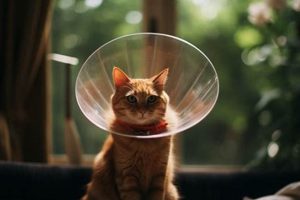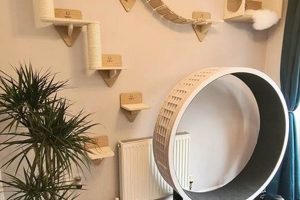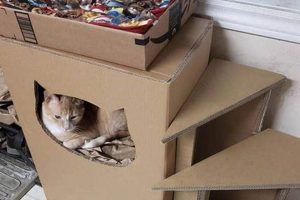Constructions intended for feline enrichment, often built by individuals from readily available materials, offer a vertical territory for climbing, scratching, and resting. An example of such a creation would be a multi-tiered structure incorporating sisal rope-wrapped posts, carpeted platforms, and enclosed hideaways.
These structures are important for promoting physical activity, reducing stress and boredom in indoor cats, and minimizing destructive behaviors towards household furniture. Historically, resourceful pet owners have utilized repurposed materials, such as old shelves, cardboard boxes, and tree branches, to create these environments, reflecting a cost-effective and personalized approach to pet care.
The subsequent discussion will explore various styles, construction techniques, material considerations, and safety precautions relevant to these feline activity centers.
Essential Considerations for Feline Activity Center Construction
Effective design and construction are paramount when undertaking the creation of feline activity centers. The following points provide guidelines for optimal outcomes.
Tip 1: Prioritize Stability: A robust base is crucial. The structure should withstand the cat’s weight and energetic movements without tipping. Consider a wide, heavy base, potentially reinforced with weights.
Tip 2: Incorporate Variety in Texture: Offer a diverse range of materials, such as sisal rope for scratching, carpet for grip, and smooth wood for resting. Different textures cater to varied feline preferences and needs.
Tip 3: Optimize Height for Climbing: Cats possess an innate drive to ascend. Design the structure with multiple levels and varying heights to satisfy this instinct and provide elevated vantage points.
Tip 4: Secure All Components: Utilize strong, non-toxic adhesives and fasteners to ensure all elements are firmly attached. Regular inspection is vital to identify and address any loosening connections.
Tip 5: Include Resting Platforms: Cats require dedicated spaces for observation and relaxation. Integrate appropriately sized platforms throughout the structure, providing both open and enclosed options.
Tip 6: Consider Cat Size and Age: Adapt the dimensions and spacing of elements to suit the size and agility of the intended user. Older cats may benefit from lower platforms and gentler inclines.
Tip 7: Ensure Material Safety: Only use materials that are non-toxic and free from sharp edges or small parts that could be ingested. Prioritize pet-safe fabrics and finishes.
Adhering to these guidelines promotes the creation of a safe, stimulating, and durable environment that caters to the natural behaviors and needs of domestic felines.
The subsequent section will address specific material selection criteria and construction techniques to further refine the process.
1. Stability
Stability represents a foundational requirement in the construction of feline activity centers. Insufficient structural integrity poses a direct safety hazard to the animal, potentially leading to injury from collapses or instability during climbing and play. The relationship between stability and structural design is therefore a cause-and-effect dynamic: inadequate design precipitates instability, while robust design ensures it. For instance, a multi-tiered structure built with a narrow base and lightweight materials is likely to be unstable, particularly when subjected to the dynamic forces of a cat jumping between levels. Conversely, a design incorporating a broad, weighted base and sturdy, interconnected components demonstrates improved stability.
The practical significance of stability extends beyond immediate safety. A structurally sound activity center will withstand prolonged use, resisting wear and tear associated with scratching, climbing, and general activity. Consider the example of a center constructed using insufficiently strong fasteners: over time, connections may loosen, leading to wobbling platforms or detached components. This not only compromises the cat’s safety but also necessitates frequent repairs or eventual replacement, increasing the overall cost and effort associated with the project. Proper joinery techniques and appropriate hardware are essential to achieving durable stability.
In conclusion, stability is not merely a desirable feature but an essential component of any feline activity center. Challenges in achieving stability can often be overcome through careful material selection, design considerations, and construction practices. A comprehensive understanding of structural principles, coupled with a focus on feline safety, ultimately ensures a durable and secure environment for feline enrichment, and thus a well designed diy cat tree designs.
2. Material Selection
The choice of materials directly influences the durability, safety, and aesthetic appeal of feline activity centers. Material selection, therefore, is not merely a cosmetic consideration but a foundational element that affects the overall suitability of structures intended for feline interaction. An inappropriate selection of materials can result in structural instability, toxicity hazards, or premature degradation, negating the benefits the activity center intends to provide. For instance, using treated lumber containing harmful chemicals presents a direct health risk to cats through contact and potential ingestion, while flimsy materials may collapse under the weight and activity of the animal.
The practical application of material selection principles extends to specific component choices. Sisal rope, chosen for its durability and natural texture, provides an ideal scratching surface. Untreated wood offers a safe and sturdy framework, allowing for secure attachment of platforms and other elements. Carpet remnants can be repurposed to create comfortable resting areas, provided that they are securely affixed to prevent ingestion. Conversely, materials like plastic or synthetic fabrics may present ingestion hazards, lack necessary grip for climbing, or degrade quickly with scratching, rendering them unsuitable for feline activity centers. The long-term performance and maintenance of these structures are equally dependent on the initial material choices.
In summary, diligent material selection is paramount to the creation of safe, functional, and enduring feline activity centers. Challenges in this area often stem from a lack of awareness regarding material properties and feline-specific hazards. By prioritizing non-toxic, durable, and appropriately textured materials, builders can construct activity centers that effectively meet the behavioral and environmental needs of domestic felines, and thus are well designed diy cat tree designs.
3. Height Variation
Height variation represents a core design element in effective feline activity centers. The integration of multiple vertical levels caters directly to the innate climbing instincts of domestic felines. A direct correlation exists between the provision of varying heights and the behavioral enrichment offered by the structure. The absence of height variation limits the cat’s ability to express natural climbing behaviors, potentially leading to boredom or destructive behaviors directed toward other household items. An example illustrating this principle is a simple, single-level scratching post, which, while providing a scratching outlet, fails to address the feline’s desire for elevated vantage points. In contrast, a multi-tiered structure with platforms at different heights offers opportunities for climbing, exploration, and secure observation of the environment, effectively addressing feline behavioral needs.
The practical significance of height variation extends to feline territoriality. Cats utilize vertical space to establish dominance and create safe zones. By providing elevated platforms, a well-designed activity center allows multiple cats within a household to occupy distinct areas, reducing conflict and promoting a harmonious living environment. The distance between levels, platform sizes, and accessibility should be tailored to the physical capabilities of the cat. For instance, lower and gently sloped ramps can facilitate access for older or less agile felines, while higher platforms cater to younger, more athletic animals. The careful consideration of these factors optimizes the benefits of height variation and contributes to the overall success of the design.
In summary, height variation is not merely an aesthetic feature; it’s an essential component directly linked to feline well-being. Challenges in incorporating adequate height variation can be overcome by carefully assessing the cat’s physical abilities, the available space, and the overall design of the diy cat tree designs. An intentional approach to height variation transforms a simple structure into a enriching and stimulating environment, promoting physical activity, reducing stress, and supporting the natural behaviors of domestic felines.
4. Scratching Surfaces
The provision of suitable scratching surfaces is integral to the functionality of feline activity centers. These structures serve as designated areas for cats to engage in a natural and essential behavior, mitigating potential damage to household furnishings and contributing to feline well-being. The type, placement, and durability of scratching surfaces directly influence their utilization by the animal.
- Material Composition and Texture
The material from which the scratching surface is constructed dictates its appeal and effectiveness. Sisal rope, corrugated cardboard, and certain types of carpet offer varied textures that cater to feline preferences. Example: Sisal rope is often favored for its durability and coarse texture, which allows cats to effectively remove the outer layers of their claws. The implications of this choice affect the long-term utility of the scratching surface.
- Orientation and Placement
The orientation of the scratching surface vertical, horizontal, or angled influences its accessibility and attractiveness to the cat. Example: Vertical scratching posts mimic the natural scratching behavior exhibited on trees in the wild, while horizontal surfaces may appeal to cats that prefer to stretch while scratching. Appropriate placement within the activity center encourages use and minimizes undesirable scratching elsewhere.
- Surface Area and Stability
Adequate surface area allows the cat to fully extend its body and claws during scratching. Similarly, a stable surface prevents movement or collapse, enhancing the cat’s confidence and willingness to engage with the scratching area. Example: A narrow, unstable scratching post is less likely to be used than a wide, firmly anchored one.
- Integration with Structure
The manner in which the scratching surface is integrated into the overall structure of the feline activity center affects both its functionality and aesthetic appeal. Example: A scratching post seamlessly incorporated into a multi-tiered platform provides both a scratching outlet and a climbing aid. Consideration of integration optimizes space utilization and encourages holistic engagement with the activity center.
The selection and strategic integration of scratching surfaces are pivotal to the success of feline activity centers, diy cat tree designs, effectively promoting natural feline behaviors and minimizing destructive scratching within the domestic environment. A thorough understanding of feline preferences, coupled with careful consideration of material properties and structural design, results in a beneficial and well-utilized scratching component.
5. Resting Platforms
Resting platforms constitute a fundamental component of well-designed feline activity centers. These platforms provide elevated spaces where cats can observe their surroundings, rest comfortably, and establish territorial boundaries. Their design and placement within the structure directly impact feline usage and satisfaction.
- Size and Shape Optimization
The dimensions and form of the resting platform dictate its usability for felines of varying sizes and preferences. Insufficient platform size compromises comfort and stability, potentially deterring use. Examples include circular platforms for curling up, rectangular platforms for stretching out, and tiered platforms for multiple felines. Proper size consideration is crucial in the context of “diy cat tree designs” to accommodate the target animal.
- Material and Texture
The surface material significantly influences platform comfort and traction. Options include carpet, faux fur, or untreated wood. The choice of material must balance comfort with durability and ease of cleaning. For example, carpeted platforms offer enhanced grip and warmth but require regular maintenance. Therefore, materials influence both cat preference and owner upkeep in “diy cat tree designs”.
- Positioning and Accessibility
Platform placement within the activity center dictates its attractiveness to felines. Higher platforms offer increased vantage points and security, while lower platforms provide easier access for older or less agile cats. Clear pathways and stable transitions between levels enhance platform accessibility. Proper planning is essential when integrating platforms into “diy cat tree designs”.
- Enclosure and Security
Enclosed platforms, such as cubbies or covered perches, offer a sense of security and privacy. These enclosed spaces cater to felines that prefer seclusion. The size and design of enclosed platforms must accommodate the cat’s size and movement. Integrating enclosed platforms within “diy cat tree designs” can enhance feline comfort and reduce stress.
Resting platforms are essential elements in diy cat tree designs. Their design and placement are critical in meeting the behavioral and comfort needs of domestic cats, supporting overall well-being and promoting utilization of the structure.
6. Safety
Safety is a paramount consideration in the creation of do-it-yourself (DIY) feline activity centers. The inherent risks associated with elevated structures and animal interaction necessitate diligent attention to design and construction practices.
- Material Toxicity
The selection of non-toxic materials is crucial to prevent ingestion-related health hazards. Certain wood treatments, adhesives, and fabrics contain harmful chemicals that can be detrimental to feline health. The utilization of untreated wood, pet-safe adhesives, and natural fibers mitigates the risk of toxicity. The implications of material toxicity include potential organ damage, allergic reactions, or gastrointestinal distress in felines.
- Structural Integrity
The stability and load-bearing capacity of the structure are essential to prevent collapse or instability during use. Inadequate construction techniques or insufficient material strength can lead to structural failure, resulting in potential injury to the animal. Reinforcing joints, utilizing appropriate fasteners, and conducting load tests enhance structural integrity. Structural failure risks include falls, crushing injuries, or entrapment.
- Sharp Edges and Protrusions
The presence of sharp edges, exposed nails, or protruding screws poses a laceration risk to felines during climbing and play. Meticulous attention to detail during construction is necessary to eliminate potential hazards. Sanding rough edges, countersinking fasteners, and covering sharp corners with protective materials minimize the risk of injury. Such hazards can result in cuts, punctures, or abrasions.
- Entrapment Hazards
Confined spaces or poorly designed openings can create entrapment hazards, particularly for kittens or smaller cats. Enclosed spaces must be adequately sized to prevent accidental confinement. Avoiding small, inaccessible openings and ensuring proper ventilation in enclosed areas mitigates the risk of entrapment. Entrapment risks include suffocation, dehydration, or panic-related injuries.
Adherence to rigorous safety standards is imperative in all aspects of DIY feline activity center construction. The long-term health and well-being of the animal depend on the proactive identification and mitigation of potential hazards, ensuring the structure serves as a source of enrichment rather than a source of danger. Neglecting these factors in diy cat tree designs can result in severe consequences.
Frequently Asked Questions Regarding DIY Feline Activity Center Construction
The following questions address common inquiries and misconceptions concerning the creation of feline activity centers constructed by individuals.
Question 1: What is the minimum recommended height for a feline activity center?
The minimum recommended height is contingent on feline size and agility but should ideally permit a full vertical stretch. A height of at least 36 inches (91 cm) is generally considered adequate for an average-sized domestic cat.
Question 2: What materials are strictly prohibited for use in feline activity centers?
Treated lumber, particularly wood treated with creosote or arsenic-based preservatives, is strictly prohibited due to toxicity. Similarly, materials containing formaldehyde or volatile organic compounds (VOCs) should be avoided.
Question 3: How can structural stability be assessed during the construction process?
Structural stability can be assessed by applying incremental weight to the structure and observing for any signs of instability or deflection. A dynamic load test, involving simulated feline activity, can further evaluate stability.
Question 4: What is the recommended spacing between platforms on a multi-tiered feline activity center?
The recommended spacing between platforms varies based on feline age and physical condition. However, a vertical distance of 12 to 18 inches (30 to 46 cm) generally accommodates most adult cats.
Question 5: What is the most effective method for attaching sisal rope to scratching posts?
The most effective method involves applying a non-toxic adhesive along the length of the post and tightly wrapping the sisal rope, securing it at both ends with staples or tacks. Overlapping each wrap will enhance grip.
Question 6: How frequently should feline activity centers be inspected for safety hazards?
A visual inspection should be conducted weekly, focusing on loose fasteners, frayed materials, and structural integrity. A more thorough inspection, including load testing and component replacement, should occur quarterly.
Safety, material selection, and structural integrity are paramount in feline activity center construction. Proper planning and execution minimize potential risks and maximize feline well-being.
The subsequent section will address advanced design considerations and customization options for DIY feline activity centers.
diy cat tree designs
The preceding discourse has explored the multifaceted aspects of “diy cat tree designs,” emphasizing the critical interplay between feline behavioral needs, structural integrity, and material safety. From the foundational importance of stability to the nuanced considerations of scratching surfaces and resting platforms, each element demands careful attention to ensure a beneficial and enduring structure.
The construction of feline activity centers represents a commitment to responsible pet ownership. By adhering to established safety protocols and prioritizing the animal’s physical and psychological well-being, constructors contribute to a higher standard of care, fostering a more enriching domestic environment. Continued diligence in design and construction practices will ensure the longevity and continued utility of these structures, benefitting both feline and owner alike.







